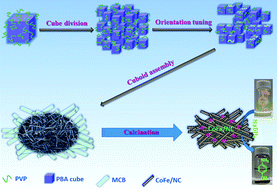Novel Prussian-blue-analogue microcuboid assemblies and their derived catalytic performance for effective reduction of 4-nitrophenol†
Abstract
Prussian blue and its analogues (PBAs) have been widely investigated in fields such as lithium-ion batteries (LIB), supercapacitors, catalysts and water splitting due to their excellent physical and chemical properties. To boost their application, various novel architectures based on PBA cubes have been fabricated. In this work, a one-dimensional (1D) Co–Fe PBA cuboid with a length of 1–2 μm was solvothermally synthesized for the first time using a Co–Fe PBA cube as the building block through a self-assembly process. Time-dependent scanning electron microscopy (SEM) observation revealed that the PBA cubes underwent a structural decomposition into smaller cubes and then assembled to cuboids along a certain preferential orientation. Fascinatingly, this method can be expanded to other PBA cubes. After annealing, the obtained Co–Fe PBA cuboid-derived product, CoFe/NC-MCBs, can be used as a hydrogenation catalyst for highly effective reduction of 4-nitrophenol (4-NP). This method provides great opportunities to fabricate novel cuboid structures with tunable chemical composition, which would promote the further application of PBA in different aspects.



 Please wait while we load your content...
Please wait while we load your content...